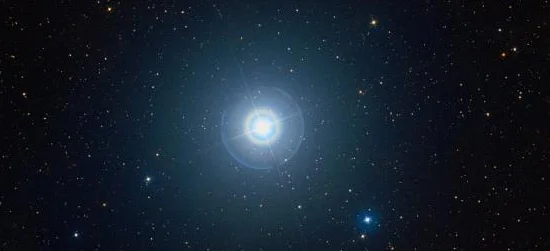Polaris, the North Star, has always been a beacon of stability, but recent discoveries have shattered that calm image. Cutting-edge observations from the CHARA Array have unveiled a hidden world of swirling surface spots and immense size, showing Polaris is far more dynamic and mysterious than we ever knew. These groundbreaking revelations are rewriting what we thought we knew about this cosmic giant—so what does it all mean for our understanding of the universe?
Polaris: The Brightest Beacon in the Night Sky
Polaris, located nearly 400 light-years from Earth, is not just any star—it is the brightest member of a triple-star system and serves as a Cepheid variable, a type of star that pulsates in brightness over time. Cepheids are essential for measuring distances across the universe, acting as “standard candles” for astronomers. Polaris plays a vital role in this process due to its predictable pulsations, which occur over a four-day cycle.
The ability to predict its brightness makes Polaris crucial in measuring cosmic distances, and by extension, the expansion of the universe. This discovery refines our understanding of Cepheid variables, allowing astronomers to improve the accuracy of these essential measurements. It’s clear that Polaris is more than just a navigational tool; it’s a keystone in our cosmic measurements.
The CHARA Array’s Groundbreaking Observations
One of the most exciting revelations from the CHARA Array’s recent work on Polaris is the discovery of its immense size—46 times larger than our Sun. This massive star was observed using the CHARA Array’s six telescopes, which combined to create a telescope with the equivalent power of a 330-meter-wide lens.
This unprecedented resolution allowed astronomers to capture detailed images of Polaris’s surface for the first time.
Using this high-resolution imaging, the research team, led by Nancy Evans at the Center for Astrophysics, Harvard & Smithsonian, identified not only the star’s vast size but also some surprising features on its surface. These discoveries would not have been possible without the advanced optical interferometry technology utilized by the CHARA Array.
Polaris’s Mysterious Surface Spots
One of the most startling discoveries was the presence of large bright and dark spots on the surface of Polaris, reminiscent of sunspots on our Sun.
These spots are a completely new finding and offer the first glimpse into what the surface of a Cepheid variable looks like. The spots appear to change over time, hinting at a dynamic and complex surface that could be driven by magnetic activity or stellar rotation.
Why is this so significant? These spots could help explain some of the long-observed variations in Polaris’s velocity, which scientists believe may be connected to the star’s 120-day radial velocity cycle.
Understanding the origins and behaviors of these spots could shed light on the internal processes driving Cepheid variables, which are still not fully understood.
Mapping Polaris’s Hidden Companion
In addition to the surface discoveries, the CHARA Array helped astronomers track the elusive companion star that orbits Polaris every 30 years.
This companion had long been suspected, but due to its faintness and close proximity to Polaris, it had remained difficult to observe until now. By resolving this binary system, astronomers were able to confirm that Polaris has a mass five times larger than the Sun, a finding that poses intriguing questions for future research.
The ability to measure Polaris’s mass with greater accuracy could have implications beyond just this star. It may lead to a better understanding of the evolution and lifecycle of Cepheid variables, helping astronomers refine their models of how these stars behave and change over time.
Why This Discovery Matters for the Future of Astronomy
The new details unveiled about Polaris could have far-reaching implications for both stellar and cosmic research. Cepheid variables like Polaris are among the most important tools for astronomers, helping them calculate distances to far-off galaxies and track the expansion of the universe.
Moreover, the discovery of surface spots on Polaris challenges existing theories about Cepheid variables, opening up new lines of inquiry into the internal dynamics of these stars. As astronomers continue to observe Polaris with the CHARA Array and other advanced instruments, they will likely uncover more surprises that could reshape our understanding of stellar physics.
In the broader context, this discovery exemplifies the power of modern astronomical technology to reveal hidden features of even the most familiar stars. The CHARA Array’s observations remind us that even stars that have been studied for centuries can still harbor secrets, waiting to be uncovered with the right tools.
Looking Ahead
What’s next for Polaris? The CHARA Array team plans to continue observing the star in hopes of better understanding the mechanisms behind its surface spots and pulsations. Future research will focus on the link between these surface anomalies and the star’s rotational and magnetic activity.
As scientists gather more data, we may soon unlock the answers to long-standing questions about Cepheid variables and their role in the universe.
The recent findings from the CHARA Array have given us a fascinating new perspective on Polaris, revealing it to be far more than just a static point in the sky. With its massive size, complex surface, and hidden companion, Polaris has become a focal point for future stellar research. As astronomers continue to peel back the layers of this iconic star, we can look forward to new discoveries that will deepen our understanding of the universe and our place within it.
Reference:
The Orbit and Dynamical Mass of Polaris: Observations with the CHARA Array. The Astrophysical Journal, 971(2), 190.



















